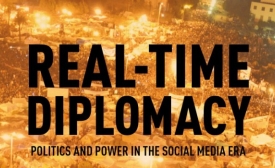arab spring
The anti-American protests raging across the Middle East and beyond are testing much more than the security at America's diplomatic missions, or even the ability of Arab leaders—many of them in nascent democracies—to address extremism.

The USC Center on Public Diplomacy was pleased to present a book talk with CPD Director, Philip Seib, on his recently published book, “Real-Time Diplomacy: Politics and Power in the Social Media Era.”
What triggered this tsunami of political upheaval? And is it localized to the Arab world, or could it spread? It is no secret that authorities in Beijing and Moscow are playing close attention, attempting to ferret out any indications that a prerevolutionary situation may be building up in their own societies...
APDS Blogger: Lydia Marcos
The durability of national governments in the Middle East and North Africa is now determined by the extent to which leaders can expeditiously and effectively address the primary cause of the Arab Spring: shameful levels of underdevelopment of the people in the context of abundant socio-economic potential.
"I think my country Sudan has really hit rock bottom." Those were the last public words uttered by Usamah Mohamad, a 32-year-old Sudanese web developer-turned-citizen journalist, in a video announcing he would join protests against President Omar al-Bashir. Mohamad, popular under his Twitter handle "simsimt," was arrested the same day his video was aired. For the next month, his family had no idea where he was. Finally they learned he was in Khartoum's high security prison and were allowed to visit him last week.
President Obama's decision last year to call for the fall of the Assad regime, in which he was followed by Britain and other allies, was, it can be argued, a mistake. The reasons were understandable. First, the regime was behaving appallingly. Second, the US did not want to be behind the curve in another phase of the Arab spring, particularly as the Damascus government was, unlike the Mubarak government in Egypt, one which it had always disliked and which was tied to regional foes of America in the shape of Iran and Hezbollah in Lebanon.
The symposium's two panels discussed the ways the United States could use technology to find and respond to atrocities. But in the high-profile use of social media during the Arab Spring, individuals in volatile political situations used their cellphones, the Internet and social media to highlight violence in their countries.







